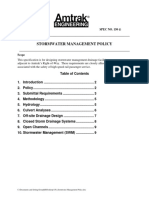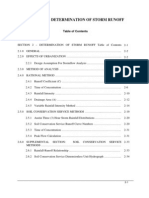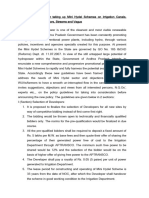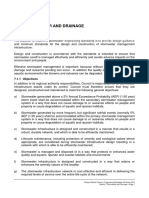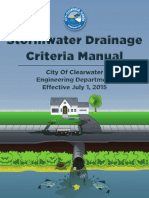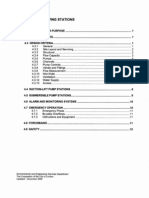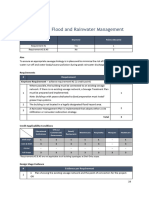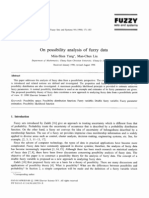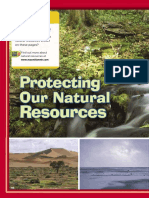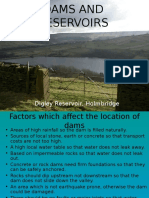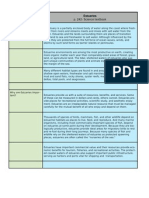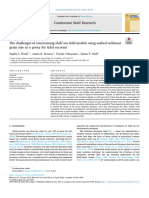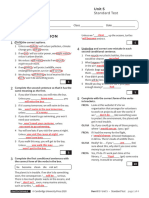Section 8 - Stormwater Management
Section 8 - Stormwater Management
Uploaded by
SudharsananPRSCopyright:
Available Formats
Section 8 - Stormwater Management
Section 8 - Stormwater Management
Uploaded by
SudharsananPRSOriginal Title
Copyright
Available Formats
Share this document
Did you find this document useful?
Is this content inappropriate?
Copyright:
Available Formats
Section 8 - Stormwater Management
Section 8 - Stormwater Management
Uploaded by
SudharsananPRSCopyright:
Available Formats
SECTION 8 STORMWATER MANAGEMENT
Table of Contents
SECTION 8 - STORMWATER MANAGEMENT Table of Contents.. 8.1.0 GENERAL ......
8-1 8-2
8.2.0 REGIONAL STORMWATER MANAGEMENT PROGRAM . 8-2 8.2.1 General ..... 8.2.2 Participation Guidelines ... 8-2 8-3
8.3.0 STORMWATER MANAGEMENT PONDS . 8-3 8.3.1 General . 8-3
8.3.2 Performance Criteria for on-Site SWM Ponds . 8-4 8.3.3 Performance Criteria for Regional SWM Ponds .. 8-4 8.3.4 Safety Criteria for SWM Ponds ... 8.3.5 Outlet Structure Design 8.4.0 DETENTION PONDS STORAGE DETERMINATION .. 8-4 8-6 8-7
8-1
Drainage Criteria Manual
SECTION 8 - STORMWATER MANAGEMENT
SECTION 8 - STORMWATER MANAGEMENT 8.1.0 GENERAL Stormwater Management (SWM) programs aimed at controlling increased urban runoff generated by development are a top priority in urban planning. More frequent flooding, increased rates and volumes of runoff, increased stream channel erosion and degradation, increased sedimentation and increased water pollution are all problems intensified by development. SWM facilities such as detention, retention, extended detention, infiltration, and sedimentation ponds have proven to significantly reduce downstream flooding, reduce sediment and pollutant loads, and provide debris removal which can benefit water quality. The basic concept of SWM for peak rates of runoff is to provide for a temporary storage of stormwater runoff. Runoff is then released at a controlled rate which cannot exceed the capacities of the existing downstream drainage systems, or the predeveloped peak runoff rate of the site, whichever is less. The solid lined hydrograph shown in Figure 8-1 in Appendix B of this Manual represents a storm runoff event without SWM, while the dashed line hydrograph depicts the same event with SWM. The peak flow of the undetained hydrograph could exceed the capacity of the downstream conveyance system and thereby cause surcharging and flooding problems. With the introduction of the SWM facility, the solid lined hydrograph is spread over a longer time period and its peak is reduced. The area between the two (2) curves to the left of their intersection represents the volume of runoff, temporarily stored or detained in the SWM facility. The City approaches the control of excess flows through the application of both on-site and regional SWM. Essentially, the distinction between the two approaches is that on-site is generally limited to site specific criteria, while regional incorporates a basin wide hydrologic analysis. 8.2.0 REGIONAL STORMWATER MANAGEMENT PROGRAM 8.2.1 General The Regional Stormwater Management Program (RSMP) provides for the planning, design and construction of regional drainage improvements, using fees paid by the owners of those developments. The RSMP uses a watershed-wide approach to analyze potential flooding problems, identify appropriate mitigation measures, and select site locations and design criteria for regional drainage improvements. These improvements include detention and retention ponds, waterway enlargement and channelization, and improved conveyance structures. The RSMP allows developers to participate in the
8-2
program (in lieu of constructing on-site controls) if the resulting use of regional drainage improvements will produce no identifiable adverse impact to other properties due to increased runoff from the proposed development. The fees charged for participation in the RSMP are non-refundable and are based upon the size of the development, and the proposed land use. The fees are deposited in a dedicated fund. The benefits afforded by the RSMP include the following: A. A higher level of confidence in the hydrologic analysis is obtained because each pond's interrelationship within a given basin can be readily determined. This is accomplished by establishing a hydrologic data base watershed master plan of the entire basin, and then using this to determine the most hydrologically efficient location for SWM facilities. This procedure takes into consideration the interrelated nature of tributary subareas within a watershed. B. Adequate maintenance is more likely due to the City's vested interest and responsibility in the RSMP. C. The cost of construction and the total land required can be considerably less than that needed for comparable on-site SWM D. The expanded land area required for regional ponds lends itself to other uses (e.g., parks, nature areas, organized sports, etc.). 8.2.2 Participation Guidelines Participation in the regional stormwater management program shall be determined according to Section 8.602(2), Chapter 8 of the City of Round Rock Code of Ordinances, 1995 edition. After a development is accepted for participation, fees shall be paid in accordance with the following: A. B. Single Family and Duplex Subdivisions. Fees shall be paid prior to plat recordation. Commercial and Multi-Family Site Development. For commercial and multi-family site development (includes triplexes, fourplexes, apartments and condominiums), payment (cash or cashier check only) must be made prior to issuance of a development permit. Multi-Family, Commercial and Industrial Subdivisions. For multi-family, commercial and industrial subdivisions, payment (cash or cashier check only) shall be made prior to final plat approval for the rights-of-way. In addition, the applicant shall assign, by plat note, the responsibility for payment of the participation fee by the individual lot developer prior to their development permit approval.
C.
8.3.0 STORMWATER MANAGEMENT PONDS 8.3.1 General Stormwater Management (SWM) ponds may be of two basic types: On-site and regional.
8-3
In general, on-site ponds are those which are located off-channel and provide stormwater management for a particular project or development. Regional ponds are designed to provide stormwater management in conjunction with other improvements on a watershed-wide basis. SWM ponds may be further classified as retention or detention ponds and may incorporate water quality Best Management Practices (BMPs) such as sedimentation, infiltration, or filtration. The performance and safety criteria in this Section apply to all ponds which provide management of peak rates of stormwater runoff regardless of type. 8.3.2 Performance Criteria for on-Site SWM Ponds A. On-site SWM ponds are further classified as either small or large, as follows: ON-SITE SWM POND CLASS Small Large DRAINAGE AREA <25 acres 25-64 acres
For design purposes, any pond with a drainage area larger than sixty-four (64) acres shall be classified as regional pond. B. On-site SWM ponds shall be designed to reduce post-development peak rates of discharge to existing pre-development peak rates of discharge for the 2, 10, and 25 year storm events at each point of discharge from the project or development site. For the post-development hydrologic analysis, any off-site areas which drain to the pond shall be assumed to remain in the existing developed condition.
8.3.3 Performance Criteria For Regional SWM Ponds A. Regional SWM ponds are classified as small and large, based on the following criteria: REGIONAL POND CLASS Small Large IMPOUNDED VOLUME, AC-FT 0-150 >150
Any regional pond with a height of dam over fifteen (15) feet shall be classified as a large regional pond. B. Performance criteria for regional ponds shall be determined by the Engineering and Development Services Department on a project-by-project basis. The determination shall be based on a preliminary engineering study prepared by the Engineer.
8.3.4 Safety Criteria For SWM Ponds All ponds shall meet or exceed all specified safety criteria. Use of these criteria shall in no way relieve the Engineer of the responsibility for the adequacy and safety of all aspects of the design of the SWM pond. A. The spillway, embankment, and appurtenant structures shall be designed to safely pass the design storm hydrograph with the freeboard shown in the table below. All
8-4
contributing drainage areas, including on-site and off-site areas, shall be assumed to be fully developed. Any orifice with a dimension smaller than or equal to twelve (12) inches shall be assumed to be fully blocked. For all spillways (especially enclosed conduits), the ability to adequately convey the design flows must take into account any submergence of the outlet, any existing or potential obstructions in the system and the capacity of the downstream system. For these reasons, enclosed conduit spillways connecting directly to other enclosed conduit systems are discouraged. If used, they must be justified by a rigorous analysis of all enclosed conduit systems connected to the spillway. DETENTION POND CLASS On-site: Small Large Regional: Small Large DESIGN STORM EVENT 25 year 25 year 100 year 100 year FREEBOARD TO TOP OF EMBANKMENT, FT. 0 1.0 2.0 *
*Design storm event and required freeboard for large regional ponds shall be determined by a dam break analysis based on the principles outlined in Title 30, Part 1, Chapter 299 of the Texas Administrative Code. The dam break analysis shall be submitted to the Engineering and Development Services Department for approval. B. If an embankment is classified as a dam pursuant to Title 30, Part 1, Chapter 299 of the Texas Administrative Code, all design criteria found in Title 30, Part 1, Chapter 299 of the Texas Administrative Code must be met, as evidenced by certification by an engineer licensed in the State of Texas. All SWM ponds shall be designed using a hydrograph routing methodology. The appropriate City of Austin rainfall distribution, as provided for in Appendix A of this Manual, shall be used to determine all runoff hydrographs. The minimum embankment top width of earthen embankments shall be as follows: TOTAL HEIGHT OF EMBANKMENT, FT. 0-5 5-15 15-+ MINIMUM TOP WIDTH, FT. 7 15 *
C.
D.
*To be determined on a case by case basis by the City Engineer. E. The constructed height of an earthen embankment shall be equal to the design height plus the amount necessary to ensure that the design height will be maintained once all settlement has taken place. This amount shall in no case be less than five (5) percent of the total fill height. All earthen embankments shall be compacted to ninety-five (95) percent of maximum density in accordance with the City of Round Rock DACS - Standard Specifications Manual.
8-5
F.
Earthen embankment side slopes shall be no steeper than four (4) horizontal to one (1) vertical. Slopes must be designed to resist erosion to be stable in all conditions, and to be easily maintained. Earthen side slopes for regional facilities shall be designed on the basis of appropriate geotechnical analyses. Detailed hydraulic design calculations shall be provided for all SWM ponds. Stagedischarge rating data shall be presented in tabular form with all discharge components, such as orifice, weir, and outlet conduit flows, clearly indicated. Stage-storage table shall also be provided. In all cases, the effects of tailwater or other outlet control considerations should be included in the rating table calculations. When designing ponds in series (i.e., when the discharge of one (1) becomes the inflow of another), the engineer must submit a hydrologic analysis which demonstrates the system's adequacy. This analysis must incorporate the construction of hydrographs for all inflow and outflow components. No outlet structures from detention, filtration and/or sedimentation ponds, parking detention or other concentrating structures shall be designed to discharge concentrated flow directly onto arterial or collector streets. Such discharges shall be conveyed by a closed conduit to the nearest existing storm sewer. If there is no existing storm sewer within three hundred (300) feet, the outlet design shall provide for a change in the discharge pattern from concentrated flow back to sheet flow, following as near as possible the direction of the gutter. Storm runoff may be detained within parking lots. However, the Engineer should be aware of the inconvenience to both pedestrians and traffic. The location of ponding areas in a parking lot should be planned so that this condition is minimized. Stormwater ponding depths (for the 100 year storm) in parking lots are limited to an average of eight (8) inches with a maximum of twelve (12 inches). Maximum depths shall be permitted only in overflow parking areas not typically in daily business. All pipes discharging into a public storm sewer system shall have a minimum diameter of eighteen (18) inches and shall be constructed of reinforced concrete. In all cases, ease of maintenance and/or repair must be assured. All concentrated flows into a SWM pond shall be collected and conveyed into the pond in such a way as to prevent erosion of the side slopes. All outfalls into the pond shall be designed to be stable and non-erosive.
G.
H.
I.
J.
K.
L.
8.3.5 Outlet Structure Design There are two basic types of outlet control structures: those incorporating orifice flow and those incorporating weir flow. Rectangular and V-notch weirs are the most common types. Generally, if the crest thickness is more than sixty (60) percent of the nappe thickness,
8-6
the weir should be considered broad-crested. The coefficients for sharp-crested and broad-crested weirs vary. The respective weir and orifice flow equations are as follows: A. Rectangular Weir Flow Equation(See Figure 8-2 in Appendix B of this Manual) Q = CLH3/2 where Q C L H B. = Weir discharge, cubic feet per second = Weir Coefficient = horizontal length, feet = Head on weir, feet (Eq. 8-1)
V - notch Weir Flow Equation(See Figure 8-2 in Appendix B of this Manual) Q = Cvtan (0/2)H2.5 (Eq. 8-2)
where Q = Weir Flow, cubic feet per second Cv = Weir Coefficient O = Angle of the weir notch at the apex (degrees) H = Head on Weir, feet C. Orifice flow equation(See Figure 8-2 in Appendix B of this Manual) Q = CoA(2gH)0.5 where Q Co A g H = Orifice Flow, cubic feet per second = Orifice Coefficient (use 0.6) = Orifice Area, square feet = Gravitation constant, 32.2 feet/sec2 = Head on orifice measured from centerline, feet (Eq. 8-3)
Analytical methods and equations for other types of structures shall be approved by the SWMD prior to use. In all cases, the effects of tailwater or other outlet control considerations should be included in the rating table calculations. 8.4.0 DETENTION POND STORAGE DETERMINATION A flow routing analysis using detailed hydrographs must be applied for all detention pond designs. The Soil Conservation Service hydrologic methods (available in TR-20, HEC-1) and the Hydrologic Engineering Center (HEC) hydrologic methods may be used. The Engineer may use other methods but must have their acceptability approved by the City Engineer.
8-7
You might also like
- Bulk Material Handling: Practical Guidance for Mechanical EngineersFrom EverandBulk Material Handling: Practical Guidance for Mechanical EngineersRating: 5 out of 5 stars5/5 (1)
- Ethekwini Design Manualmay 2008Document50 pagesEthekwini Design Manualmay 2008Thabiso MatomeNo ratings yet
- 7-1 Stormwater Drainage System DesignDocument3 pages7-1 Stormwater Drainage System DesignMuhammad IqbalNo ratings yet
- Amtrak Spec No.150Document10 pagesAmtrak Spec No.150Manish KumarNo ratings yet
- Stormwater Report 7-12-2017 PDFDocument162 pagesStormwater Report 7-12-2017 PDF22091971No ratings yet
- Chapter 1 - Design Acceptance CriteriaDocument16 pagesChapter 1 - Design Acceptance CriteriaSuhaidi AliasNo ratings yet
- Draft: Development Design Credits and Total Suspended Solids Removal CriteriaDocument6 pagesDraft: Development Design Credits and Total Suspended Solids Removal CriteriababeNo ratings yet
- ADOT - Bridge Hydraulics GuidelinesDocument10 pagesADOT - Bridge Hydraulics GuidelinesbobbyccwNo ratings yet
- Chap-6 - Hydrologic Analysis For Drainage Facilities DesignDocument35 pagesChap-6 - Hydrologic Analysis For Drainage Facilities DesignChhomNo ratings yet
- Stormwater Design Manual Chapter FiveDocument40 pagesStormwater Design Manual Chapter FiveAkram AliNo ratings yet
- Section 2 - Determination of Storm RunoffDocument37 pagesSection 2 - Determination of Storm RunoffSudharsananPRSNo ratings yet
- Rational FormulaDocument2 pagesRational FormulaJai Singh RathorNo ratings yet
- Stormwater and DrainageDocument11 pagesStormwater and DrainageLa FoliakNo ratings yet
- Proposed Drainage SystemDocument22 pagesProposed Drainage SystemFarhanah Faisal100% (1)
- Sewarage DesignDocument29 pagesSewarage DesignAbhik Bhattacharjee100% (1)
- Stormwater Design Criteria Manual: September 2007Document60 pagesStormwater Design Criteria Manual: September 2007ليلى بلتاجيNo ratings yet
- Storm Water Drainage System Design Manual: August 2007Document70 pagesStorm Water Drainage System Design Manual: August 2007Wan RidsNo ratings yet
- Chapter 9 Channels: Office of Structures Manual On Hydrologic and Hydraulic DesignDocument23 pagesChapter 9 Channels: Office of Structures Manual On Hydrologic and Hydraulic DesignSubija IzeiroskiNo ratings yet
- Chesterfield County Environmental Engineering Reference ManualDocument209 pagesChesterfield County Environmental Engineering Reference Manualbarlaa02No ratings yet
- 08 BridgesDocument33 pages08 BridgesMessayNo ratings yet
- 685Document4 pages685Balu Mahendra SusarlaNo ratings yet
- Stormwater Management Policy 2020Document17 pagesStormwater Management Policy 2020sbs23037No ratings yet
- Arizona Riprock ProtectionDocument43 pagesArizona Riprock ProtectionS CollinsNo ratings yet
- 15.05 - Stormwater Drainage Design V2Document18 pages15.05 - Stormwater Drainage Design V2engrfarhanAAA100% (1)
- Design StandardsDocument14 pagesDesign StandardsMarllon LobatoNo ratings yet
- Stormwater DesignDocument105 pagesStormwater DesignrcallikanNo ratings yet
- DCR VSWCB 038Document21 pagesDCR VSWCB 038Mark KillgoreNo ratings yet
- Format DSRP Report Drip2Document63 pagesFormat DSRP Report Drip2Noli CorralNo ratings yet
- Section 4 DrainageDocument30 pagesSection 4 DrainageomarizaidNo ratings yet
- VOL 2 Part 4Document18 pagesVOL 2 Part 4anon_899476443No ratings yet
- Chapter 7: Stormwater Management: Regulatory FrameworkDocument22 pagesChapter 7: Stormwater Management: Regulatory FrameworkfawazbakerNo ratings yet
- Chapter 7 Storm Water and Drainage 20140401Document59 pagesChapter 7 Storm Water and Drainage 20140401omarizaidNo ratings yet
- CC Utilcritmanual Rules ManualDocument37 pagesCC Utilcritmanual Rules ManualAntonio PérezNo ratings yet
- Preliminary Report: Problem Definition: Water QualityDocument21 pagesPreliminary Report: Problem Definition: Water Qualityapi-19793735No ratings yet
- Detention and Retention FacilitiesDocument52 pagesDetention and Retention FacilitiesMaicol MenaNo ratings yet
- Operations and Maintenance Stormwater Drainage Requirements - GuidelineDocument14 pagesOperations and Maintenance Stormwater Drainage Requirements - GuidelineBarrasons Engineers Team0% (1)
- Policy: CDOT Drainage Design Manual PolicyDocument12 pagesPolicy: CDOT Drainage Design Manual PolicyRotsapNayrbNo ratings yet
- MPWH - Storm Water. Extracted Pages PDFDocument107 pagesMPWH - Storm Water. Extracted Pages PDFN V Sumanth VallabhaneniNo ratings yet
- Darebin Design and Legal Point of Discharge GuidelinesDocument34 pagesDarebin Design and Legal Point of Discharge GuidelinesAdam CleggNo ratings yet
- Guidelines For Earth Fill DamsDocument23 pagesGuidelines For Earth Fill DamsjnfNo ratings yet
- Stormwater Requirements For New DevelopmentsDocument24 pagesStormwater Requirements For New DevelopmentsBarrasons Engineers TeamNo ratings yet
- Basic Principles and Concepts of DrainageDocument4 pagesBasic Principles and Concepts of DrainagejohnsonNo ratings yet
- Sewagepump Station ManualDocument28 pagesSewagepump Station Manualwatsol.egyptNo ratings yet
- On Site Detention GuidelinesDocument36 pagesOn Site Detention GuidelinesWing MacNo ratings yet
- General Guidance For The Design of DamsDocument8 pagesGeneral Guidance For The Design of Damsalmutaz9000No ratings yet
- Dam Safety Guidelines 2020Document58 pagesDam Safety Guidelines 2020Nsiandumi nkyaNo ratings yet
- Section 10-Hydraulic Design Aspects of BridgesDocument19 pagesSection 10-Hydraulic Design Aspects of BridgesjohnsonNo ratings yet
- Stormwater Drainage Criteria ManualDocument29 pagesStormwater Drainage Criteria ManualCharinafranz1123No ratings yet
- HydrologyDocument33 pagesHydrologyGregor KokotNo ratings yet
- 4 Sewage Pumping StationsDocument14 pages4 Sewage Pumping StationsMassi MateenNo ratings yet
- Dug Wells 1.0. GENERALDocument9 pagesDug Wells 1.0. GENERALVinayak KoliNo ratings yet
- Forwarding Letter and GuidelinesDocument31 pagesForwarding Letter and Guidelinesye yint100% (1)
- 3.11 Permit Requirements 3.11.1 GeneralDocument3 pages3.11 Permit Requirements 3.11.1 GeneralSingDollarNo ratings yet
- SS-01 Sewage, Flood and Rainwater ManagementDocument6 pagesSS-01 Sewage, Flood and Rainwater Managementhaifa.alpinNo ratings yet
- An Operation and MaintenanceDocument6 pagesAn Operation and MaintenanceMaría MadridNo ratings yet
- Competitiveness of South Asia's Container Ports: A Comprehensive Assessment of Performance, Drivers, and CostsFrom EverandCompetitiveness of South Asia's Container Ports: A Comprehensive Assessment of Performance, Drivers, and CostsNo ratings yet
- Sewage Disposal Works: Their Design and ConstructionFrom EverandSewage Disposal Works: Their Design and ConstructionNo ratings yet
- Technical Aspects Related to the Design and Construction of Engineered Containment Barriers for Environmental RemediationFrom EverandTechnical Aspects Related to the Design and Construction of Engineered Containment Barriers for Environmental RemediationNo ratings yet
- Mapping Hazards in Nepal’s Melamchi River: Catchment to Enhance Kathmandu’s Water SecurityFrom EverandMapping Hazards in Nepal’s Melamchi River: Catchment to Enhance Kathmandu’s Water SecurityNo ratings yet
- Groundwater Studies UNESCODocument423 pagesGroundwater Studies UNESCOSudharsananPRSNo ratings yet
- Water Quality AssessmentDocument6 pagesWater Quality AssessmentSudharsananPRSNo ratings yet
- Water Resources YieldDocument34 pagesWater Resources YieldSudharsananPRSNo ratings yet
- Assessment of Water Quality Using GISDocument8 pagesAssessment of Water Quality Using GISSudharsananPRSNo ratings yet
- Open Channel FlowDocument74 pagesOpen Channel FlowRabar Muhamad86% (7)
- Design of Concrete Gravity DamDocument26 pagesDesign of Concrete Gravity DamSudharsananPRSNo ratings yet
- Control of Water Pollution From Agriculture - Idp55e PDFDocument111 pagesControl of Water Pollution From Agriculture - Idp55e PDFSudharsananPRSNo ratings yet
- P258 TranDocument5 pagesP258 TranSudharsananPRSNo ratings yet
- Rainfall Estimation From Sparse Data With Fuzzy B-Splines: Giovanni GalloDocument10 pagesRainfall Estimation From Sparse Data With Fuzzy B-Splines: Giovanni GalloSudharsananPRSNo ratings yet
- PHD Thesis ShresthaDocument222 pagesPHD Thesis ShresthaAnca ŞtefancuNo ratings yet
- Yang N 12 Possibility AnalysisDocument13 pagesYang N 12 Possibility AnalysisSudharsananPRSNo ratings yet
- Portrayal of Fuzzy Recharge Areas For Water Balance Modelling - A Case Study in Northern OmanDocument7 pagesPortrayal of Fuzzy Recharge Areas For Water Balance Modelling - A Case Study in Northern OmanSudharsananPRSNo ratings yet
- Merle Parvis 1950 Drainage PatternDocument35 pagesMerle Parvis 1950 Drainage PatternnarareynehcNo ratings yet
- Content Outline - Caribbean CSEC GeographyDocument4 pagesContent Outline - Caribbean CSEC GeographyS.L.L.CNo ratings yet
- G84-690 Estimating Soil Moisture by Appearance and FeelDocument9 pagesG84-690 Estimating Soil Moisture by Appearance and Feelwarren del rosarioNo ratings yet
- Treasures G3 U4 T3Document13 pagesTreasures G3 U4 T3Cruz EscobedoNo ratings yet
- Types of Volcanoes Guided NotesDocument3 pagesTypes of Volcanoes Guided Notesapi-264090670No ratings yet
- CBSE Class 7 Science Our Environment Chapter 3 Our Changing Earth Important Questions 2024-25Document6 pagesCBSE Class 7 Science Our Environment Chapter 3 Our Changing Earth Important Questions 2024-25shantabhatiNo ratings yet
- Dams Reservoirs-A - Alison QuartermanDocument27 pagesDams Reservoirs-A - Alison QuartermanEng-Ali Hasan Al-homamNo ratings yet
- Date: Project: Report:: Damodar River BasinDocument33 pagesDate: Project: Report:: Damodar River Basinmrinal kayalNo ratings yet
- Science Activity Sheet Quarter 4 - MELC 1 Week 1: Types of SoilDocument10 pagesScience Activity Sheet Quarter 4 - MELC 1 Week 1: Types of SoilShareinne TeamkNo ratings yet
- The Water CycleDocument9 pagesThe Water Cycleapi-547758460No ratings yet
- Module 1 Actiivity Cross-Word PuzzleDocument3 pagesModule 1 Actiivity Cross-Word PuzzleNoreelyn RemolacioNo ratings yet
- Advanced Matching - Weather PDFDocument1 pageAdvanced Matching - Weather PDFcreatura dNo ratings yet
- Lec 9 - Physical EnvironmentDocument40 pagesLec 9 - Physical EnvironmentAngelica Lopez67% (3)
- Letter of Transmittal: Ehsanur Rauf PrinceDocument57 pagesLetter of Transmittal: Ehsanur Rauf PrinceMd Khaled NoorNo ratings yet
- Estuaries Cornell NotesDocument3 pagesEstuaries Cornell Notesapi-169639475No ratings yet
- Volcano Case Studies 5 & 6Document11 pagesVolcano Case Studies 5 & 6Mahmud RahmanNo ratings yet
- The Baltic SeaDocument2 pagesThe Baltic SeaAgnieszka Wieteczka WietechaNo ratings yet
- Continental Shelf Research: Sophie L. Ward, James D. Scourse, Yusuke Yokoyama, Simon P. NeillDocument10 pagesContinental Shelf Research: Sophie L. Ward, James D. Scourse, Yusuke Yokoyama, Simon P. Neillfaris nauvalNo ratings yet
- CsUnit5 Standard Test With AnswersDocument4 pagesCsUnit5 Standard Test With AnswersSpeak EnglishNo ratings yet
- Analog Geophysical Survey of Meren Jacket 102-WIP RouteDocument26 pagesAnalog Geophysical Survey of Meren Jacket 102-WIP RouteolalekanNo ratings yet
- Simplified Keys To Soil Series Negros OrientalDocument64 pagesSimplified Keys To Soil Series Negros OrientalNoy JuanNo ratings yet
- Final Exam SCience 1Document2 pagesFinal Exam SCience 1Deonne Alexa CabtalanNo ratings yet
- 10 Amazing Facts About BrazilDocument3 pages10 Amazing Facts About BrazilAdela EidNo ratings yet
- Phyto-Plankton Diversity of Sharda River Within Tanakpur DistrictDocument3 pagesPhyto-Plankton Diversity of Sharda River Within Tanakpur DistrictJournal of Environment and Bio-SciencesNo ratings yet
- Cape Geography SyllabusDocument9 pagesCape Geography SyllabusKern Grant100% (2)
- State of The Parks 2001Document170 pagesState of The Parks 2001WildNo ratings yet
- Program Book SI HATHI Surabaya FINALDocument19 pagesProgram Book SI HATHI Surabaya FINALgreg felanNo ratings yet
- Furrow Irrigation System Design PDFDocument27 pagesFurrow Irrigation System Design PDFamir_mNo ratings yet
- Unit 5 CoursebookDocument12 pagesUnit 5 Coursebookfilippo lunardonNo ratings yet
- Volcanic Eruptions: Sneha Sara Varghese 36Document12 pagesVolcanic Eruptions: Sneha Sara Varghese 36snehasara10No ratings yet



